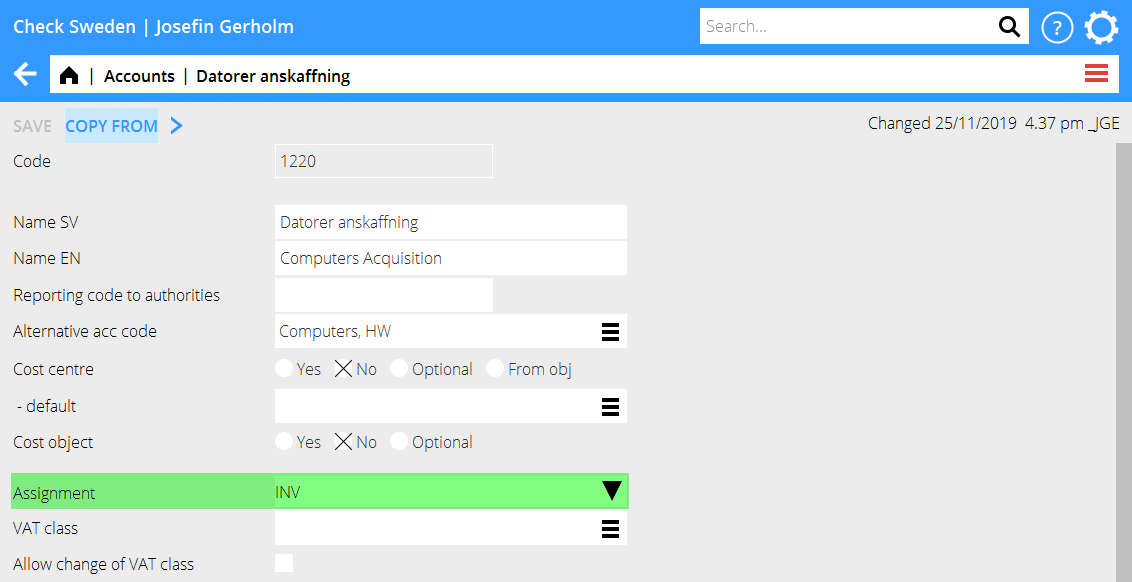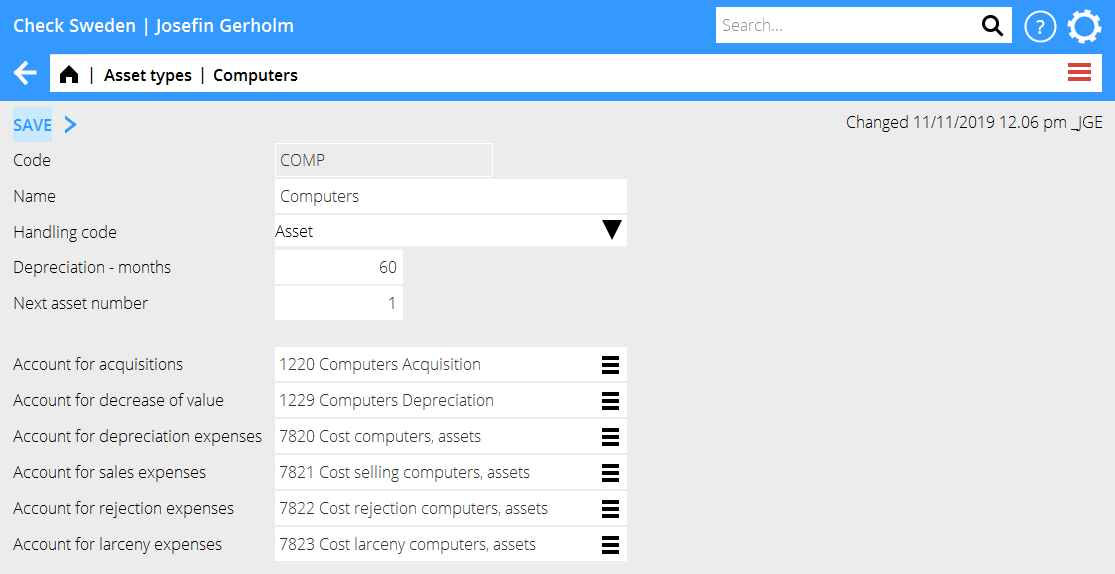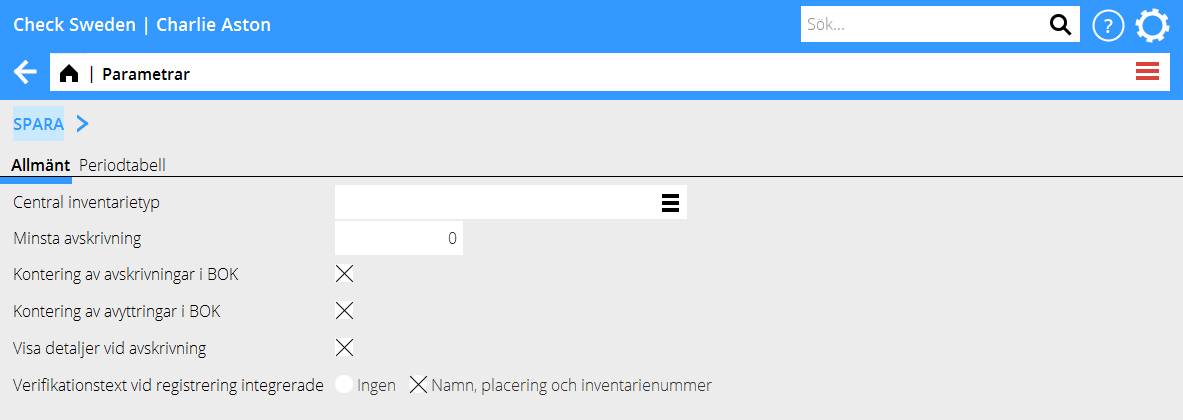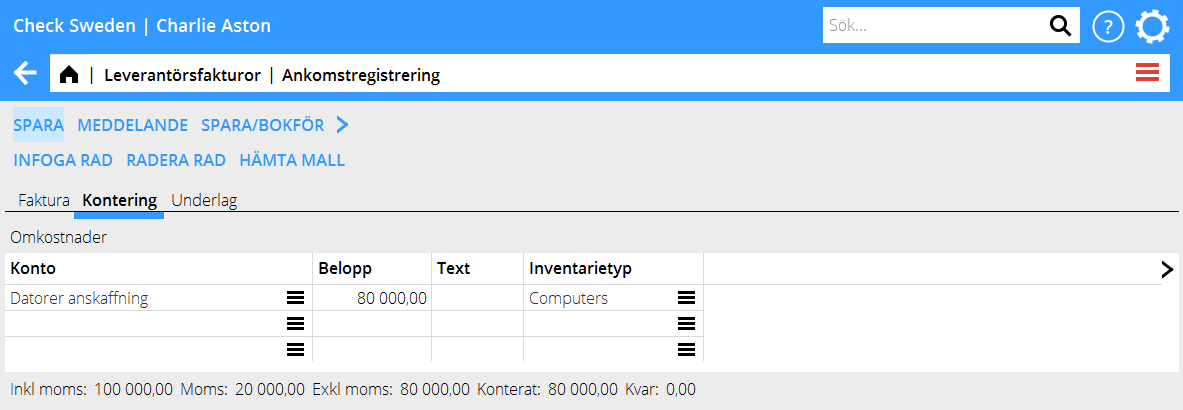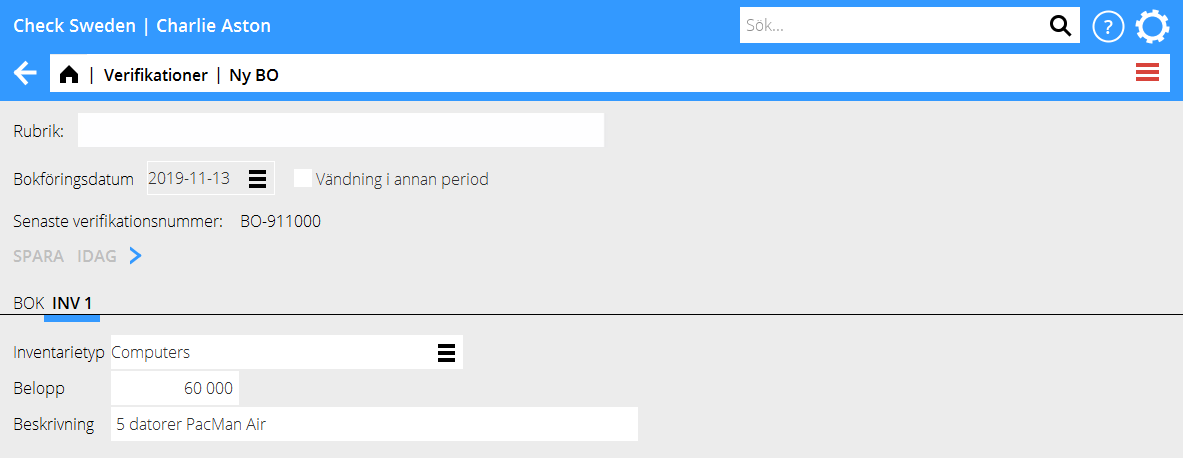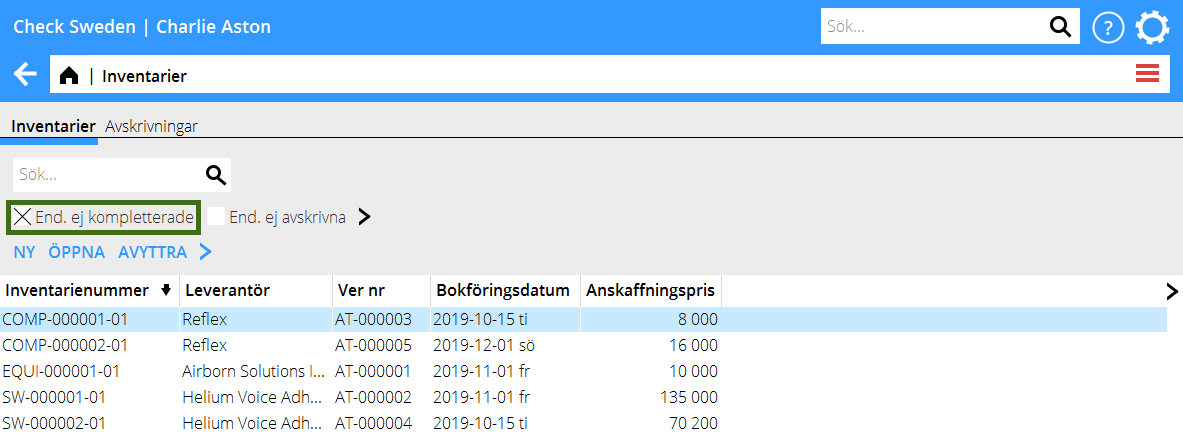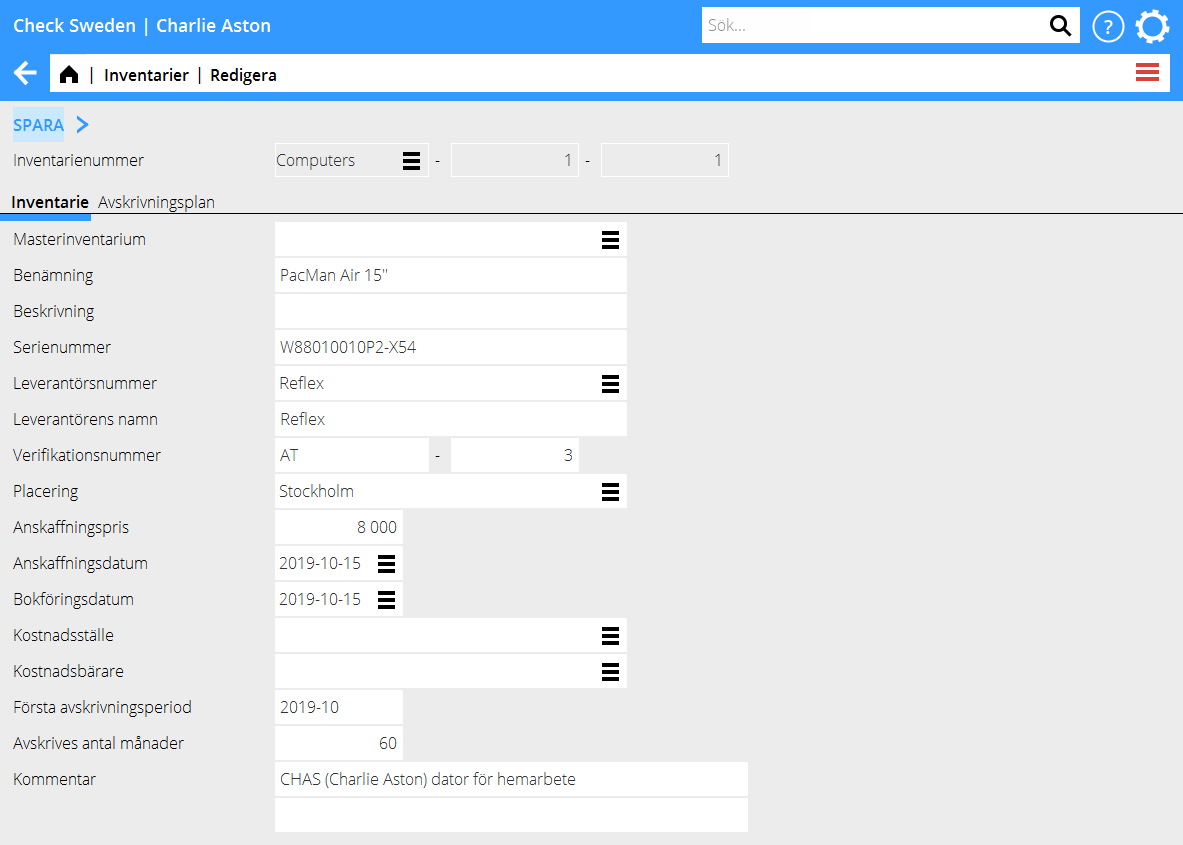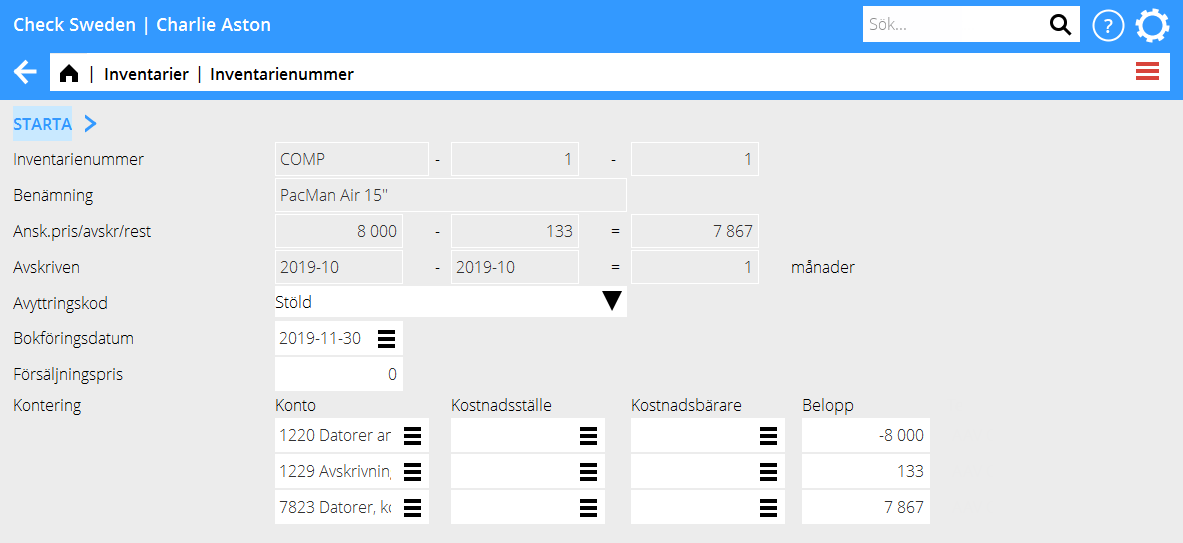Anleggsregister/Inventarer
Contents
Anleggsregister i Marathon
Anleggsregistret er en separat modul i Marathon for håndtering av selskapet sine inventarer. Den er integrert med bokføringen; inventarerna registreres enten som leverandørsfakturaer eller som manuelle bilag og avskrivninger og avhendinger konteres på de kontoer som er oppgitte på forskjellige inventarsorter.
Innstillinger og grunnregister
Det finnes visse innstillinger som rører funksjonene i anleggsregistret.
Integrasjon på konto
Anskaffelseskontoerne måtte ha integrasjon til anleggsregistret for at inventarer fra bokføring og leverandørsfakturaer skulle registreres. Innstillingen ligger på kontoen i Grunnregister: BOK/Kontoer. Velg INV i integrasjonsfeltet.
Inventarsorter
Alle inventarer i Marathon må tilhøre en inventarsort. Inventarsorten styr konteringene ved avskrivning og foreslår antall avskrivningsmåneder. det er også en måte for p kategorisere inventarer. Inventarsortene registreres i Grunnregister: INV/Inventarsorter.
| Koden | må være maksimalt fire tegn og er oftest en forkortelse av navnet til sorten, f eks, DATA for Datamaskiner. |
|---|---|
| Håndteringskoden | styrer avskrivningsreglene til inventarsorten:
Inventar er den mest brukte koden; inventarer med denne sort kan bli avskrevne og avhendte med automatisk kontering. Leasing genererer ikke avskrivninger og kostnadsfører heller ikke noen del av anskaffelsen, uten håndterer inventaren som leasing. Kostnadsført kan brukes for registreing av inventarer som kostnadsf8res direkte ved anskaffelse. Budsjett muliggør budsjettering av inventarer. I rapporter som rører anleggsregistret kan man lage selekteringer med håndteringskoder. |
| Feltet Avskrivninger- måneder | Viser ett forslag på antall avskrivningsmå for denne inventarsort. Nummeret kan endres for enkelte inventarer. |
| Neste inventarnummer | viser nummeret på neste inventar som blir registrert. Nummeret er i formatet XXXX-NNNNNN-NN hvor XXXX er koden til inventarsorten, NNNNNN et serienummer for hovedinventaret og det siste NN ett underserienummer til hovedinventaret. Ett eksempel på inventarnummer: DATA-000001-01 |
| Nummerseriene | kan holdes separate pr. inventarsort. Det er også mulig å bruke en sentral nummerserie for flere eller alle inventarsorter. Dersom du bruker sentrale nummerserier, må Neste inventarnummer være 0. |
| Konto for anskaffelser | brukes ved booking av nye inventarer og avhendinger. Ved tiden for anskaffelse
debiteres hele kostnaden til inventaret. Ved tiden for avhending foreslås kreditering av hele beløpet, men den kan endres. |
| Konto for verdiminskning | brukes ved avskrivninger og avhendinger. Ved avskrivning krediteres beløpet. Ved avhendingforeslås debitering av hele det tidligere avskrevne beløpet. |
| Konto for kostnad ved avskrivning | brukes vid avskrivning. Ved avskrivning debiteres hele beløbet. Ved avhending foreslås debitering av den totale tidligere avskrevne summen. |
| Konto for kostnad ved salg | brukes ved salg. Vid salg foreslås at resterende beløp debiteres. |
| Konto for kostnad ved skrotning | Brukes da invventarer skrotes |
| Konto for kostnad ved svinn | Brukes ved svinn av inventarer |
Vi foreslår at dere bruker flere separate kontoer for hver inventarsort og konteringssort.
Plasseringskoder
Plaseringskoder kan brukes for å kople inventarer til forkjellige avdelinger, f eks kontor eller etasjer. Plasseringskoder registreres i System: Grunnregister/INV/ Plasseringskoder och krever kun en kode og ett navn.

Parametrer
Parametre som påvirker anleggsregistret finnes i System: Grunnregister/INV/ Parametrer. Generell inventartype må angis dersom en eller flere inventarnummer vil bruke en sentral nummerserie. Alle inventartyper med 0 i Neste inventarnummer bruker den sentrale nummerserien. Det er den nummerserie på inventarsort som brukes som er registrert her.
Parametrene Kontering av avskrivninger i BOK og Kontering av avhendinger i BOK styr hvis avskrivninger og avhendinger vil konteres automatisk i bokføringen. Dersom det ikke er avkrysset, må man booke manuelt for at anleggsregister og bokføring skulle stemme.
Register assets
Assets can be registered through three different programs.
Through the purchase ledger
If the inventory comes from a suppliers’ invoice you can register it whilst posting the invoice. Enter acquisition account for the asset. Om only one asset type is assigned to this account, the asset type will be suggested in the field Asset type. If several asset types are assigned to the account, the field must be completed manually.
Through bookkeeping voucher
Enter acquisition account for the asset. The tab INV will be created. There, state Asset type, Amount and Name. Return to the tab GL and complete the posting before you save the voucher.
Through manual registration
It is possible to register assets directly in the inventory ledger. A manual registration has also to be manually booked so that the subsystems will agree. Manual asset registration is done in Accounting: Assets, by pressing New.
Complete assets
Assets that have been entered to the system with a supplier’s invoice or a voucher must be completed in Accounting: Assets, tab Depreciation Check the box Only not completed to see a list of assets not yet completed.
Open the asset and state at least First depreciation period. You can also write in other completing information such as Serial number, Placement and Comment.
Depreciation of assets
Depreciations are done in Accounting: Assets, tab Depreciation. Write To period for the depreciation and accounting date. You can choose to only depreciate a certain type of asset. If you leave the field empty, all asset types will be included. You can start with making a test print to get a list of what the depreciation includes and how the postings will be. When you have checked that it looks correct, remove the tick from Test print and then print.
Disposal
To dispose an asset, go to Accounting: Assets, tab Assets. Select the asset and press Sell. Choose the code that correlates to type of disposal and accounting date. If the disposal is due to sales, enter also Sales price. The posting for the disposal is suggested based on the remaining amount on the asset, possible sales price and the accounts you have set on the asset type. The posting can be corrected manually. When the posting is ready, press Start.
Split asset
If you want to split one asset into many assets; select it in Accounting: Assets, and press Split. In the table, register name, placement and acquisition price, one row per asset.
All assets that are created by a split get the same main number but separate subnumbers. For example, asset COMP-1-1 that gets split to two gets numbers COMP-1-1 and COMP-1-2.
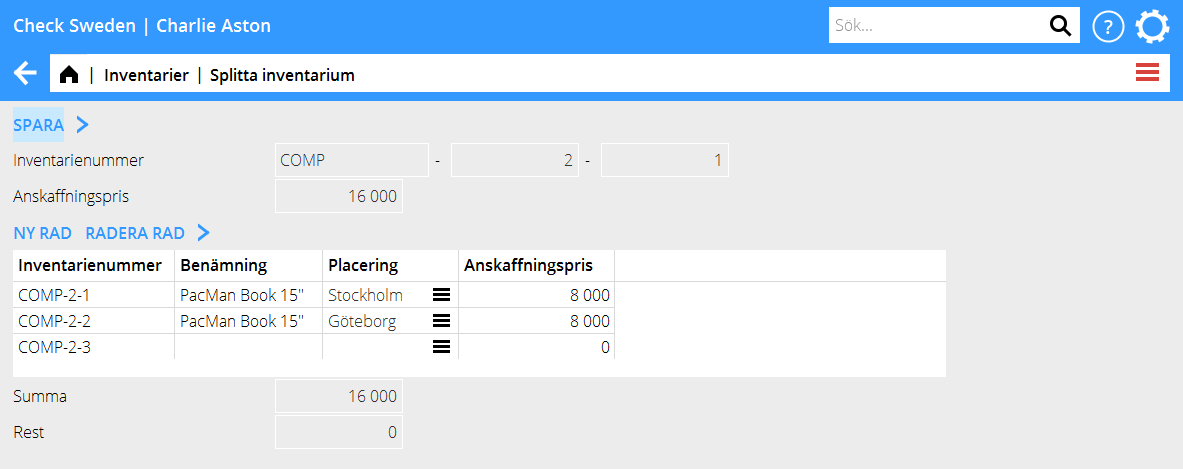
Change asset number
If you have an asset that for some reason has ended up in wrong asset type or gotten a wrong number, you can correct it in Accounting: Assets, tab Assets. Select the asset and press Change number and write the number the asset shall be moved to. Note that the bookkeeping must be manually corrected in order for the subsystems to agree.
Edit depreciation plan
The assets are depreciated with a flat depreciation plan, Acquisition price/Number of depreciation months. An asset for 60 000 SEK that shall be depreciated in 60 months is thus depreciated with 1000 SEK per month. There are two ways of changing the depreciation plan.
1.Edit depreciation plan (only correcting future depreciations)
If you want to change the depreciation pace of an asset’s remaining amount, open the asset in Accounting: Assets, tab Assets, tab Depreciation plan. State correction month in the field From period. The column To period is normally left blank; the new plan concerns hence all future depreciations. The new depreciation plan is valid from and including the month stated in the From period field. Already performed depreciations are not affected. Example: Acquisition price 60 000 SEK. First depreciation period 01-2019. Months to depreciate = 60. Performed depreciations as of 12-2019. New depreciation plan from period 01-2020 and forward with depreciation months = 12. During 2019 12 depreciations have been made with 1 000 SEK /month. Remaining amount after 2019 = 48 000 SEK. Depreciations 01-2020 and forward will be 5 000 SEK (60 000 SEK / 12).
2.Edit months (correction retrospectively)
If the asset’s depreciation plan is erroneous and you want to correct also already performed depreciations, you can change months directly on the asset Accounting: Assetst, tab Assets, tab Asset. The next depreciation will correct previous depreciations based on the new number of months. Example: Acquisition price 60 000 SEK. First depreciation period 01-2019. Months to depreciate = 60. Performed depreciations to 12–2019. Change in field Months to depreciate on the asset = 24, which means monthly depreciation of 2 500 SEK. During 2019 there has been 12 depreciations of 1 000 SEK/month = 12 000 SEK. In 01–2020, 20 500 SEK is depreciated. 2 500 SEK for 01-2020 and 18 000 SEK that corrects the previous depreciations for 2019 (60 000 / 24 * 12 - 12 000).
Reports
Inventory ledger reports is found in Accounting: Reports, tab Inventory ledger.
The report List depreciations is a standard report that lists assets selected on depreciation period, accounting date and asset type.
The report Reports is used for printing reports with tailor-made column templates.
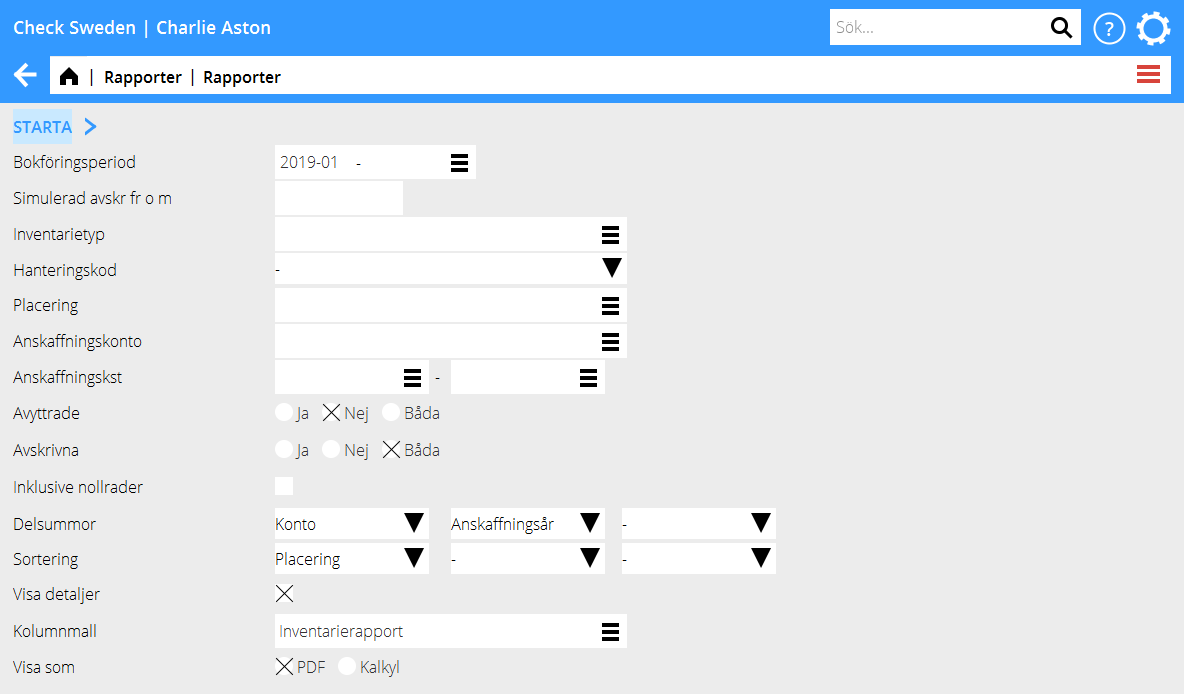
[Category: Accounting] [Category: ACC-INV-EN] [Category: Manuals]
